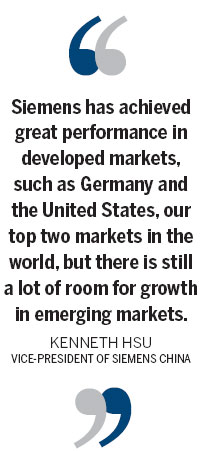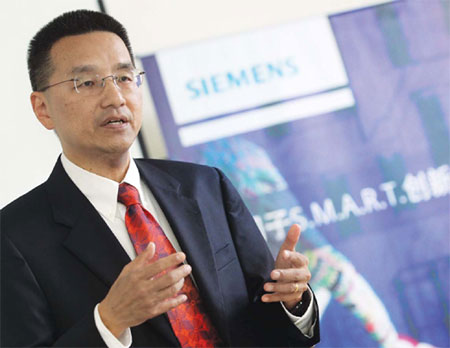Siemens gets lowdown on getting smart
Updated: 2012-11-09 10:05
By Meng Jing (China Daily)
|
|||||||||||
|
Arding Hsu, head of corporate technology with Siemens China, says there is a better chance of the company becoming a game changer if it can better understand the needs of Chinese customers. Provided to China Daily |
Industrial giant goes down-market to up success
In the winter of 2010, when Siemens' global research and development team was busy working in Berlin on the fourth generation of protective relays, with new features, better technology and a higher price tag, the company's China team was moving in the opposite direction.
By cutting functions that Chinese customers didn't need in the electromechanical power system safety device and adding those they did, the 30 researchers at Siemens China produced their first "In China, for China" protective relay to market in April, and priced it about 40 percent cheaper than the global version.
This seeming downgrade in Siemens China's innovation is not an exception. Rather, it is part of a trend to innovate SMART products - simple, maintenance-friendly, affordable, reliable and timely to market - a major move designed to help the German conglomerate tap the middle and lower-end markets in emerging economies. And China is Siemens' top target market.
"Siemens has achieved great performance in developed markets, such as Germany and the United States, our top two markets in the world, but there is still a lot of room for growth in emerging markets," says Kenneth Hsu, vice-president of Siemens China, who believes SMART innovation is the way to gain more market share in China.
The majority of Siemens' products are made in line with a one-fits-all strategy to meet the needs of many countries.
 |
The traditional innovation process leads to high-end, feature-rich products with time-consuming R&D and a high maintenance cost, if products need to go back to the company's headquarters in Germany for repair.
So when Arding Hsu took over as head of corporate technology with Siemens China in late 2004, his first instinct was that Siemens' innovation in China could never follow the lead taken in the West.
"There is no country in the world that has as many diversified demands as China," he says. "As long as we can better understand the needs of Chinese customers, there is a better chance of us becoming the game changer in the market."
One of the major inspirations behind his SMART innovation strategy is a simple music box his wife has been using to learn how to sing.
"In the US, people usually use iTunes to download music and they also need to buy a specially made speaker for their iPod, which can cost nearly 2,000 yuan ($320; 250 euros), if they want to hear the music out loud.
"But in China, there is a music box, which is a speaker for around 90 yuan. You can simply fill your memory stick with songs and plug it into the music box, which is not only simple but a lot cheaper."
Moving down-market is important for Siemens to tap into the price-sensitive emerging markets and Kenneth Hsu says there is a lot room in China's mid-to-lower end market for Siemens to develop.
The strategy is especially important for Siemens at present. The company reported "continuous revenue growth in a more challenging market" in its Q3 financial report in July.
The report highlights indicators that show the weakness of the macro global economy, in particular across Europe. The European market is traditionally a key market for Siemens but the company sees "orders substantially below prior years", according to the report.
However, Kenneth Hsu emphasizes Siemens is not shifting focus from its typical high-end market, but rather expanding its portfolio with more low-cost, locally made no-frills products, which have the most potential in China.
In the automation sector, for example, the total market size in China in 2011 was about 34.5 billion yuan, of which 47 percent was for middle to high-end products, and 53 percent for lower-end varieties.
Zhuo Yue, head of automation and control automation solution at Siemens' corporate technology department, is in charge of developing the first SMART protective relay in China. He says the main reason this market has been dominated by Chinese domestic companies is because of the low price.
"We've successfully cut down 30 to 40 percent of the cost with our new 'In China, for China' design," Zhuo says, adding that they remain competitive.
"In the six months after we put the products on the market in April, we received around 21,000 orders."
The protective relay tailor-made for Chinese customers is one of thousands of products Siemens has produced since Arding Hsu and another senior executive came up with the SMART innovation idea in Beijing's Beihai Park in 2005.
Arding Hsu is leading 380 researchers as they seek and try various ways to fill the gap between Chinese customers' needs and the actual supply in the market.
For example, they use an ant farm to help study the working conditions of mine workers and explore where there might be a demand in the mining sector. The key then is to find simple and affordable solutions.
In another sector, Shen Hong, head of research group image and data processing for emerging markets, is working with his Beijing-based corporate technology team to develop online software to train doctors in small hospitals.
After visits to rural hospitals, Shen's team found that the problem was more a lack of qualified doctors than of high-end expensive equipment - although the company has also found ways of reducing the cost of such equipment.
Siemens' magnetic resonance imaging factory in Shenzhen, South China's Guangdong province, has developed an MRI machine seen as the most affordable on the market. It has sold well in China and is being welcomed by developed markets, such as the US and Japan.
No one is sure how much revenue SMART products have generated for Siemens, but Kenneth Hsu says there is no doubt their growth is much faster than that of the company's traditional products in terms of sales.
mengjing@chinadaily.com.cn
(China Daily 11/09/2012 page19)
Today's Top News
Rescuers race against time for quake victims
Telecom workers restore links
Coal mine blast kills 18 in Jilin
Intl scholarship puts China on the map
More bird flu patients discharged
Gold loses sheen, but still a safe bet
US 'turns blind eye to human rights'
Telecom workers restore links
Hot Topics
Lunar probe , China growth forecasts, Emission rules get tougher, China seen through 'colored lens', International board,
Editor's Picks

|

|

|

|

|

|






